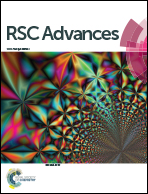Titanium dioxide and fluoropolymer-based coating for smart fabrics with antimicrobial and water-repellent properties†
Abstract
In the coronavirus disease 2019 pandemic, protective clothing is required for medical staff at risk of infection. This study proposes functional smart fabrics with antimicrobial and water-repellent properties, using titanium dioxide (TiO2) and fluoropolymer-based precursors as coating materials. Experimental results indicated a uniform distribution of TiO2 particles with an average size below 200 nm throughout the fabric. A zone of inhibition test revealed that the fabric inhibited bacterial growth, specifically of Staphylococcus aureus and Klebsiella pneumoniae, before and after 10 wash cycles of the fabric. In wetting angle measurements, the contact angles of water droplets on the fabric ranged from 120° to 139°. A water repellency test confirmed that the coated fabrics retained their water-repellent property after 10 wash cycles.



 Please wait while we load your content...
Please wait while we load your content...